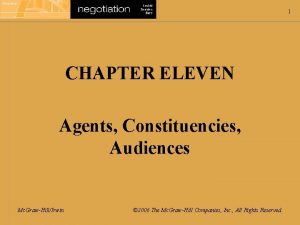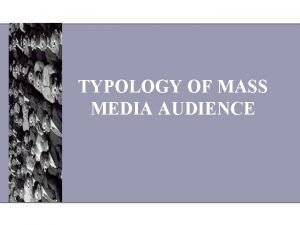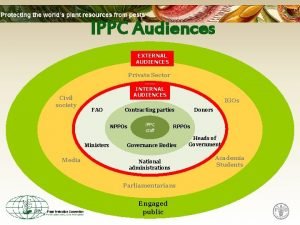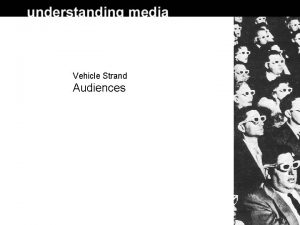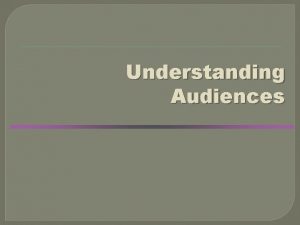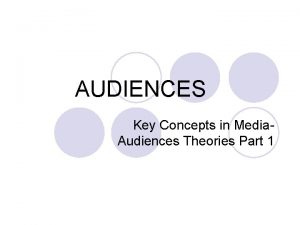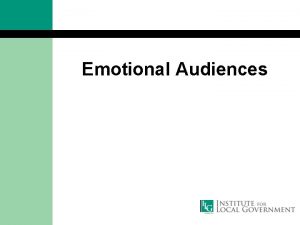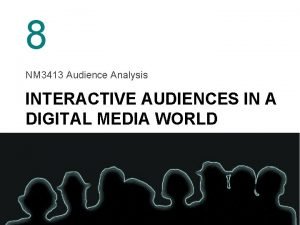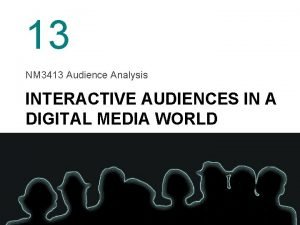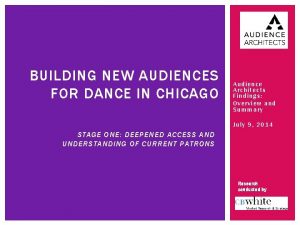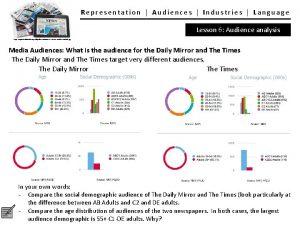Supportive Audience for Indies Supportive Audiences College Students



























- Slides: 27

Supportive Audience for Indies • Supportive Audiences • College Students • Singles/Childless Couples • Discriminating Viewers • Informed Viewers • Frequent Moviegoers

Dominant Aesthetics • Resolved or happy ending • Effects • Clear likeable protagonist • Gendered films • Introduction or Exposition: Explanation of setting, basic character attributes, equilibrium • Introduction of conflict, obstacles, • Ensuing Events dealing with conflict • Conclusion, outcome, ending.

• Character centered causality and the definition of the action as the attempt to achieve a goal are both central features of the Classical Hollywood Film

Plot • Undisturbed stage • The Disturbance • The Struggle • And the elimination of the disturbance

Two Plotlines • One involving heterosexual romance • The other involving another sphere work, war, a mission or quest

Scenes • Continuation of time, space and action (cause and effect) • A scene may be temporally closed, but it is causally open • Each scene displays distinct phases • Exposition • Middle—move towards their goals • Action must be left suspended

• Continuation of time, space and action (cause and effect) • A scene may be temporally closed, but it is causally open • Each scene displays distinct phases • Exposition • Middle—move towards their goals • Action must be left suspended

Defying Conventions • If a film (or text) does not correspond to the canonic story, the spectator must adjust his or her expectations and posit, however tentatively, new explanations for what is presented

Movie Demographics • Since 1970’s Teens have been the most reliable movie goers • They can make or break movies during the opening weekend • In 1976 before the teen epidemic: The two leading movies were: One Flew Over the Cuckoo’s Nest and All the President’s Men • In 1977 the highest grossing movie was Star Wars and through the 80’s Hollywood was targeting kids between the ages 12 -20 • In 1990’s teen moviegoers were outnumbered by middle aged boomers between the ages 40 -49

Artistic Innovation of Indies • Existing Conventions Violated • Plays against audience’s expectations • Most American Filmmakers go out of their way to fulfill those expectations • Revolutionary Innovations disrupt routine patterns and involve deliberate changes in film language

NIGHT OF THE LIVING DEAD GEORGE ROMERO 1968

Meaning • Text: the meaning created by either written word, images or moving images • Does the Canon matter? • “What was the film about? ” • “What does the film say? ” • Does the author ultimately matter? The original intent?

Latent Image • After graduating Carnegie Mellon University George Romero formed a film company (Latent Image) • In 1967 after having a successful business Romero along with his partners came up with the idea for Night of the Living Dead

IMAGE 10 • Romero’s company contacted Pittsburgh- based industrial film firm called Hardman Associates, Inc. , and pitched their idea for a then-untitled horror film • Romero’s Company joined with them and formed Image 10 • They raised 114, 000 for Night of the Living Dead

Low Budget Film • Black and White Film Stock • A “Cheap Monster Movie” • Shot north of Pittsburgh in rural Butler County • Concept with minimal special effects • Blood is chocolate syrup and the entrails/flesh came from an actor who owned a chain of butcher shops • $114, 000 • After a decade of re-releases it made 30 million internationally

Historical Context • Vietnam era United States • Race Relations (Casting Duane Jones as the hero was in 1968, potentially controversial) • In 1964, [2] Poitier became the first black person to win an Academy Award for Best Actor, [3] for his role in Lilies of the Field. [Guess Who's Coming to Dinner 1967—top box office star • Assassinations of Martin Luther King, Jr. and Malcolm X • Counterculture

Premiered on October 1, 1968 at the Fulton Theater in Pittsburgh as a Saturday afternoon matinee—preteens and adolescents were there. The rating system wasn’t present until November of 1968, so children were present. "They were used to going to movies, sure, and they'd seen some horror movies before, sure, but this was something else. " According to Roger Ebert(who was present), the film affected the audience immediately.

Plausibility • Zombie Outbreak (fantastical) • Documentary like feel • Still photographs • Audience is asked to believe that the horrific events depicted could be happening (now. ) • Asks us to believe that there are rational explanations for the zombie's existence

Taboo: is a strong social prohibition (or ban) relating to any area of human activity or social custom that is sacred and forbidden Cannibalism Matricide

Structure • beginning (the graveyard • • • scene), a middle (the defense of the farmhouse) end (conclusion) there are no forward jumps or flashbacks (seemingly real time) the film's uncomplicated narrative structure produces a concentrated, taut drama, uncompromised by digressions or subplots.

Tragedy • Raymond Williams' argument, in his Modern Tragedy (1966), that tragedy consists not simply in the deaths of great leaders, but in the heroic and pointless destruction of "ordinary" people in their struggles for democracy.

Obsession with Apocalypse • Romero's film emerged at a time of strong public disapproval of the American military involvement in Vietnam, during which criticisms of patriotism — while deeply offensive to the American establishment — were becoming commonplace. • nuclear holocaust

Communication, Alienation, and Isolation • interpersonal communication through dialogue • focusing on the ways in which our preconceptions of others make us suspicious and even hostile towards them, and the lies we tell to ourselves and to others. • The media is omnipresent. Early in the film, there is a lengthy scene in which Ben and Barbra don't speak, but listen to the radio • who is the enemy? At first it seems obvious that it is the zombies; later, however, as the paranoid human beings fight among themselves, the distinction between human beings and zombies becomes blurred.

• Human failure of cooperation • Cooper locking himself up in basement • restoration of family values is seen as the answer to social problems in many other films—(denied in this film) • Night of the Living Dead is set at a time of racial upheaval and protest in America.

Hegemony • Domination of a diverse culture by a ruling class • Beliefs, explanations, perceptions and values • Perpetuates universally dominant ideology that justifies the social, political and economic status quo as natural, inevitable perpetual and beneficial for everyone • The absence of the identity of the ruling class (they are invisible while all others have an identity) • “I don’t see race”

Gender • Women are represented as weak, hysterical and infantilized

• What emotions are you feeling at the end of this film? • How does your experience of this film differ from other horror films that you have seen? • If the social upheaval of the late 60’s made the zombie apocalypse resonate then, what makes it resonate today?
 Alin ang hindi katangian ng isang alcaldia
Alin ang hindi katangian ng isang alcaldia Invoked audience
Invoked audience How agents, constituents and audiences change negotiations?
How agents, constituents and audiences change negotiations? Nature of audience in mass communication
Nature of audience in mass communication Media literacy definition
Media literacy definition Example of active audience
Example of active audience Psychographic groups media
Psychographic groups media Rizal carved the image of the virgin mary
Rizal carved the image of the virgin mary Harper college
Harper college The academic success inventory for college students
The academic success inventory for college students Career jeopardy game
Career jeopardy game Social media etiquette for college students
Social media etiquette for college students Who's who in american colleges and universities
Who's who in american colleges and universities Umass amherst ssn
Umass amherst ssn Borra hål för knoppar
Borra hål för knoppar Mat för unga idrottare
Mat för unga idrottare Bris för vuxna
Bris för vuxna Argument för teckenspråk som minoritetsspråk
Argument för teckenspråk som minoritetsspråk Etik och ledarskap etisk kod för chefer
Etik och ledarskap etisk kod för chefer Trög för kemist
Trög för kemist Indikation för kejsarsnitt på moderns önskan
Indikation för kejsarsnitt på moderns önskan Datorkunskap för nybörjare
Datorkunskap för nybörjare Returpilarna
Returpilarna Rita perspektiv
Rita perspektiv Redogör för vad psykologi är
Redogör för vad psykologi är Lek med geometriska former
Lek med geometriska former Claes martinsson
Claes martinsson Nyckelkompetenser för livslångt lärande
Nyckelkompetenser för livslångt lärande


